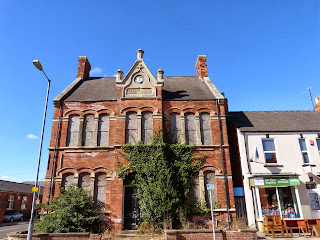I love this first exhibit, a very large Gents specimen, as most large timepieces in Victorian railway stations tend to be circular designs with Roman numerals. This one defies all conventions by being square, very plain, and with Arabic numerals.
The size of the clock can be better appreciated in the picture below.
But York is a very traditional Victorian railway station, and so it is only right and proper that it also has a classic round clock, with Roman numerals and an ornamental bracket. The picture below also gives a glimpse of the great arched and curved trainshed which makes it one of the finest stations in the country.
For information, the station was opened in 1877, replacing a previous version that was located within the city walls which made through journeys more difficult. (The city walls are another reason for visiting York). At the time of opening it was supposedly the largest station in the world.
Back to the clock, which has this curious additional face on the edge of the casing, which faces passengers crossing over the footbridge.
I assume that this is all linked to another clockface located above W H Smith, which backs on to the main clock.
That is quite an impressive show of clocks for one station, but there is more to come. Over the exit to the station is a rather utilitarian clock (Gents again). However, I am a bit worried that the old semaphore signal suggests that a train might plough through this concourse.
And there is still more. On the outside of the station, above the bus stops, is another bracket mounted clock (Gents again).
You can see the observation wheel in the distance in the picture below. I didn't bother to go on it, and didn't see many other people on it either. York to me seems like a city that needs to be explored on foot, and if you need a bit of elevation you can walk around the fine walls.
Let's move away from the station (for railway lovers, we will visit the National Railway Museum in a later posting) and around the corner into Blossom Street. Here we find the Bar Convent, which is described on its website as museum, conferencing, café, guesthouse, chapel, garden, shop - quite impressive for what appears to be a relatively small building. It is also England's oldest convent, founded in 1686.
The clock was linked by a driving rod in 1790 to the original Hindley clock of 1770 in the central court (which I only found out about in subsequent research or else I would have gone in to see it. And the menu for afternoon teas looks good).
On the opposite side of the street is the Premier Inn (or rather confusingly two Premier Inns linked together sort of) where I stayed - well how could I resist staying in a hotel with a clock?
I assume that this clock tower originally served a building with another purpose - a department store perhaps? [11 November 2013 - thanks to the blog York Stories (www.yorkstories.co.uk) I now know that this building used to be Forsselius Garage, a car showroom].
Unfortunately the clock is not in the best of conditions, and is certainly no longer working.
So, time for some rest in the hotel before we hit the sights of York.



















































